The Ultimate Road Trip
by Bob
Brooke
Hop into your car and prepare for the
ultimate road trip—a virtual one at that. Walking through the doors
of the AACA
Museum in Hershey, Pennsylvania, is for antique and vintage
car lovers a step over the threshold into paradise.
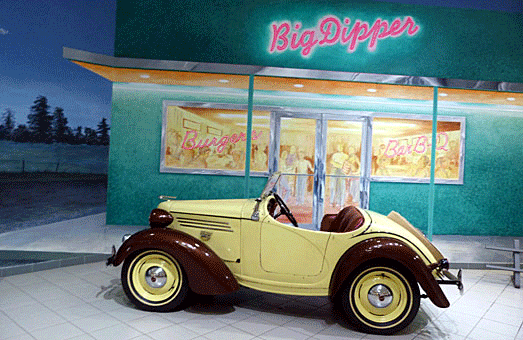
The AACA----Antique Automobile Club of America—Museum is a rather large,
sprawling building housing displays of all sorts of motor vehicles and
vehicle-related exhibits. The Museum has over 150 vehicles in their
collection, and while not every one of them is on display at one time,
they rotate regularly. At any one time, you can see 85 to 100 of them.
Permanent exhibits illustrate the history of the automobile in America
from an 1896 Chicago Motor Benton Harbor to a pair of 1917 Pierce Arrows
to the sleek vintage cars of the 1940s and 1950s to 1980s—all laid out
on the ground and first level. The third level features displays of
motorbikes and a large collection of hood ornaments from Europe and the
United States.
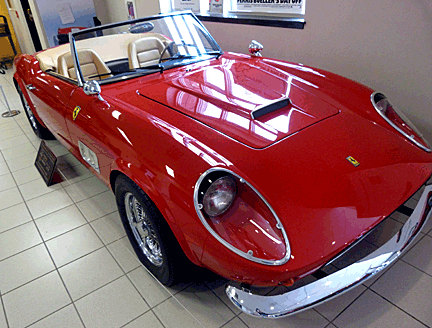 Even
before you get to the Main Gallery, a small fleet of cars greets you in
the two-story atrium. This time it’s Ford Mustangs, part of a special
temporary exhibit featuring this iconic car. Off to the right in front
of the museum shop sits the 1985 Modena Spyder, better known as "The
Ferris Bueller Ferrari" from the film “Ferris Beuller’s Day Off,” and
made especially for it, in all its shiny red glory. Even
before you get to the Main Gallery, a small fleet of cars greets you in
the two-story atrium. This time it’s Ford Mustangs, part of a special
temporary exhibit featuring this iconic car. Off to the right in front
of the museum shop sits the 1985 Modena Spyder, better known as "The
Ferris Bueller Ferrari" from the film “Ferris Beuller’s Day Off,” and
made especially for it, in all its shiny red glory.
|
This museum offers
the ultimate road trip all in one place. |
The Main Event
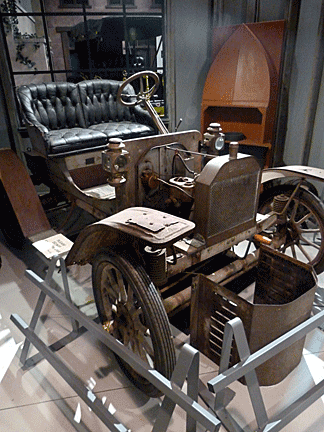 You’ll
feel as if you’ve stepped back in time as you stroll into the Main
Gallery. This contains the essence of the Museum’s ever-changing
permanent collection arranged in some iconic, if not quirky displays. You’ll
feel as if you’ve stepped back in time as you stroll into the Main
Gallery. This contains the essence of the Museum’s ever-changing
permanent collection arranged in some iconic, if not quirky displays.
Just inside the entrance is a recreation of a machine shop where early
cars were constructed part by part by hand. Across from in is a 1908
Model B Brush Runabout in “as is” condition. Turn the corner and a 1920s
auto seems to be emerging from a Pennsylvania covered bridge. Across
from it is an early car with one of the first folding campers, complete
with two bed springs and a dresser, attached to it. In its heyday, it
would have also had two mattresses—the ultimate in RV comfort
A
trio of 1930s and 1940s beauties seem to be parked in front of an Art
Deco hotel in Miami’s
 South Beach. Further on, the passengers in several
cars from the 1950s and 1960s seem to be enjoying the latest feature at
a Drive-In Theater. South Beach. Further on, the passengers in several
cars from the 1950s and 1960s seem to be enjoying the latest feature at
a Drive-In Theater.
Across the way is a 1940s gas station, complete with pumps with gas
globes on top and the station owners office, fitted out to the last
detail. A 1935 Autocar Atlantic Tank Truck sits parked nearby.
One of the newest exhibits on permanent display showcases a road trip
along historic Route 66. Set against an existing backdrop of the
Colorado Rockies are exhibits of Native American artifacts and original
porcelain driving signs. “The Mother Road,” as John Steinbeck called it,
was the route Dust Bowl farmers took seeking a new life further west.
And after World War II, thousands took to the road seeking adventure
amid the flashy neon signs and tourist attractions along the way.
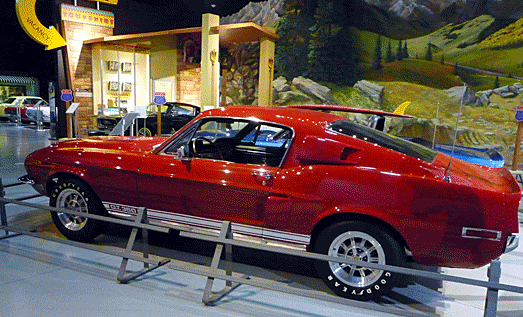
MB
The new Tucker Motor Car exhibit makes up for it, however. While vintage
car afficionados may know about Tucker automobiles, they’re not as well
known to ordinary visitors. They were vehicles way ahead of their time
and the display of three of the cars, engines, and other accessories
brings that home. What graces the floor of this gallery is the result of
Preston Tucker’s vision and determination. This is the world’s largest
collection of Tucker 48 cars and memorabilia from one person, David
Cammack. Front wheel drive and rear mounted engines were still concepts
of the future in 1948. Only 51 of these cars were ever produced and
three of them are here. The Tucker 48, dubbed the “Car of Tomorrow,” is
a fitting end to the Museum’s Main Gallery.

Down Below
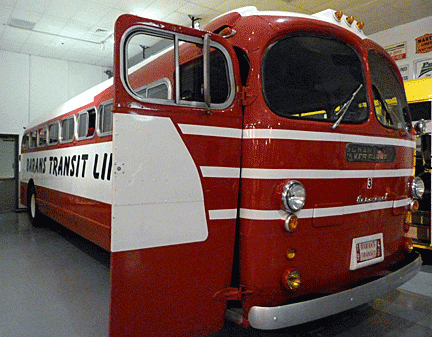 The
lower level of the Museum houses the American Museum of Bus
Transportation, as well as more motorcycles, historic vehicles from the
Museum’s permanent collection, and a real portable Valentine diner from
the 1940s, the FloInn, complete in every detail down to the menus and
the food. A Florida Highway Patrol Mustang police cruiser from 1992, complete with early radar, is
parked out front. The
lower level of the Museum houses the American Museum of Bus
Transportation, as well as more motorcycles, historic vehicles from the
Museum’s permanent collection, and a real portable Valentine diner from
the 1940s, the FloInn, complete in every detail down to the menus and
the food. A Florida Highway Patrol Mustang police cruiser from 1992, complete with early radar, is
parked out front.
On display is the largest collection of buses under one roof in the
country. A dozen buses and an illustrated timeline trace the history of
bus transportation, from the days of crank starts and wicker seats to
full-sized motor coaches complete with uniformed hostesses. Examples of
touring and city buses from the early 1900s to the 1960s are open for
inspection. Trailways is well represented.
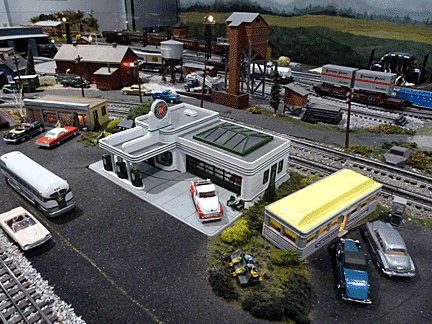 The
room next to the diner contains a model train display, “Roads to Rails,”
with a focus on model cars and car-related activities. Plasticville
buildings establish the 1950s time frame. Travel back in time as the
O-Gauge trains take you to “Tuckerville, the Museum’s vision of
small-town America of the 1950s. A Plasticville Frosty Bar has a number
of cars pulled in for soft ice cream. The trains are motion activated,
plus push buttons all around the edges of the display operate a variety
of actions such as the Ferris Wheel and carousel in the amusement park,
a hook and ladder truck backing into the fire station, firemen putting
out a fire in a railroad switching tower, a sawmill, and an operating
Drive-in Theater. There’s even a car wash without a roof that shows a
car moving through it with the wheel pads spinning. The
room next to the diner contains a model train display, “Roads to Rails,”
with a focus on model cars and car-related activities. Plasticville
buildings establish the 1950s time frame. Travel back in time as the
O-Gauge trains take you to “Tuckerville, the Museum’s vision of
small-town America of the 1950s. A Plasticville Frosty Bar has a number
of cars pulled in for soft ice cream. The trains are motion activated,
plus push buttons all around the edges of the display operate a variety
of actions such as the Ferris Wheel and carousel in the amusement park,
a hook and ladder truck backing into the fire station, firemen putting
out a fire in a railroad switching tower, a sawmill, and an operating
Drive-in Theater. There’s even a car wash without a roof that shows a
car moving through it with the wheel pads spinning.
Special Exhibits
 Besides its vast permanent displays, the Museum features periodic
temporary exhibits. One of the largest current exhibits, running until
October 14, features Ford Mustangs—lots and lots of them—from original
1964 models to souped up Shelbys and customized Saleens. Ford launched
the Mustang on January 1, 1964, half way through the model year. The
1964½ model hit the showroom floor on June 1, 1964. Another temporary
exhibit is on display in a small gallery off the lobby and features Ford
Thunderbirds. Though there MB Besides its vast permanent displays, the Museum features periodic
temporary exhibits. One of the largest current exhibits, running until
October 14, features Ford Mustangs—lots and lots of them—from original
1964 models to souped up Shelbys and customized Saleens. Ford launched
the Mustang on January 1, 1964, half way through the model year. The
1964½ model hit the showroom floor on June 1, 1964. Another temporary
exhibit is on display in a small gallery off the lobby and features Ford
Thunderbirds. Though there MB
are only three on display, members of the
International Thunderbird Club switch them out periodically.
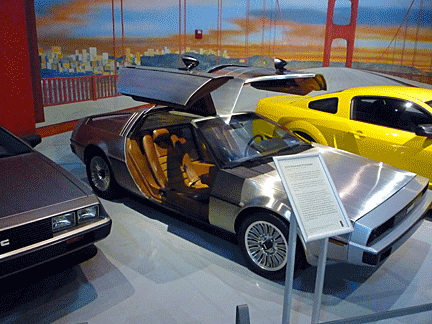 Another
smaller exhibit features highway road maps, presented by the Road Map
Collector’s Association. Since the advent of automobiles, motorists have
needed to know how to get to their destination, and for many decades
they relied on highway maps. Local gas stations, tire companies, banks,
tourist bureaus, chambers of commerce, and rental car companies all gave
away maps of local towns, cities, regions, and states. Another
smaller exhibit features highway road maps, presented by the Road Map
Collector’s Association. Since the advent of automobiles, motorists have
needed to know how to get to their destination, and for many decades
they relied on highway maps. Local gas stations, tire companies, banks,
tourist bureaus, chambers of commerce, and rental car companies all gave
away maps of local towns, cities, regions, and states.
MB
And you can’t ignore the two DeLoreans that will take you “Back to the
Future.” The prototype and the production model sit side by side for an
up-close and personal inspection.
A Herd of Mustangs
The special Mustang exhibit begins in the lobby with iconic models such
as a Mustang named “Eleanor” from the movie “Gone in 60 Seconds,” The
original models Ford launched on January 1, 1964 and later the 1964½ in
June of that year are also here.
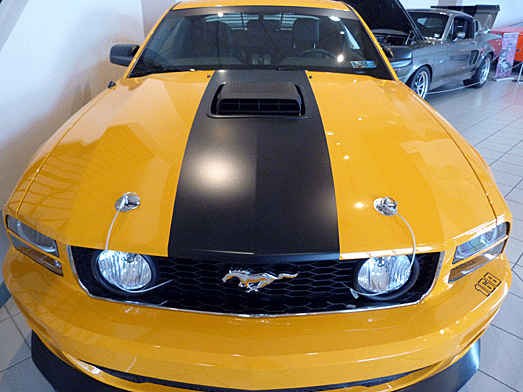
If you’re a Mustang lover, you’ll be ecstatic over the six generations
of them on display, beginning with the 1963 Mustang III Concept Show
Car, a Saleen prototype, boss Mustangs, and an early special order
prototype Mustang produced for Henry Ford II.

Manufacturers encouraged the production of pedal cars to promote their
brand. And Ford was no exception. Pristine little cars stand along side
their big brothers in the Mustang exhibit. After all, every boy wants a
car like daddy’s.
Inside this museum, you’ll find something from every article in this
latest edition of The Antiques Almanac, from old gas pumps
and globes to old highway maps and oil cans, hood ornaments, road signs
and even some information on U.S. Route 66. There’s even a complete gas
station, with products for sale, invoices, cans of oil and lube, and
brightly lit gas pumps “outside.”
NOTE:
Photos marked MB
were taken by Michael Bowers.
More Photos
from the AACA Museum
<
Back to More Antiques to View
Next Article > |
